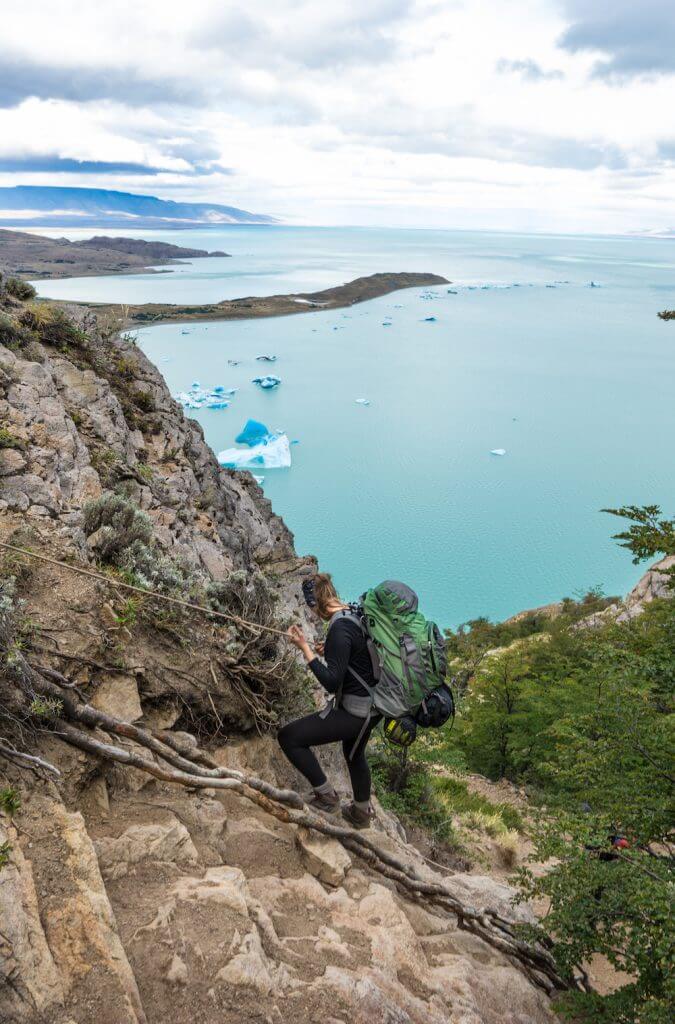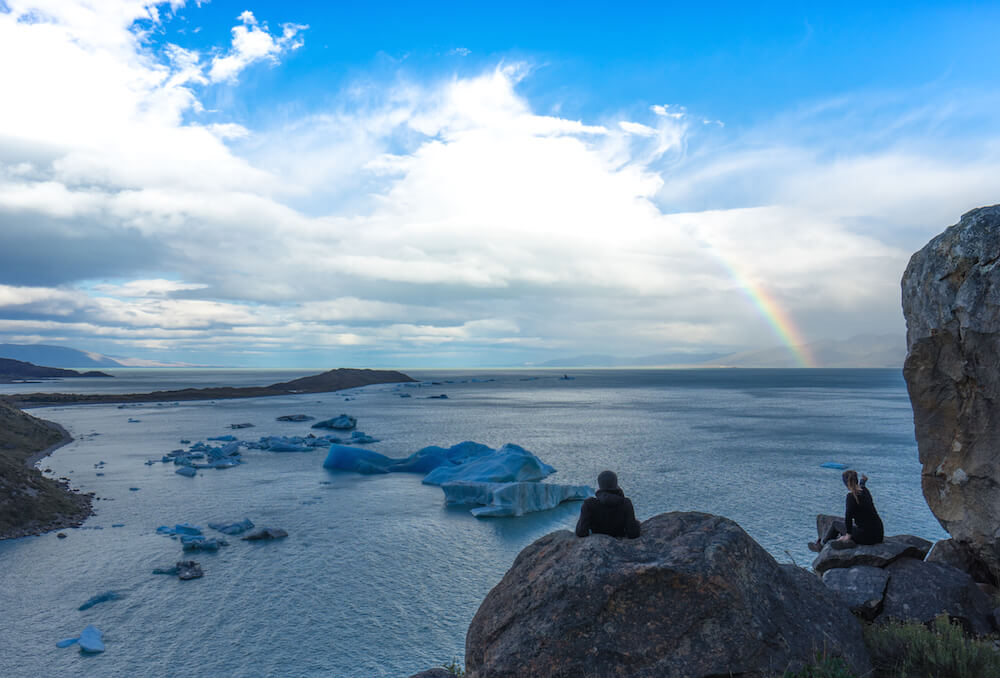I stuck my arm out and latched onto a tree to prevent myself from careening down the trail. I caught it just in time as my body kept moving but the tree, thankfully, pulled me back like a puppet on a string. I’d been warned that this trail would be ridiculously difficult but it fell on deaf ears. In fact, it only made me want to do it more.
Standing there, I thought, “They were right but I don’t want to admit it,” while simultaneously wishing to myself that curling into a ball on the floor, melting into a puddle and dripping down the rest of the trail was an option. I was in the middle of a 3-hour descent that was almost vertical, on slippery dirt, and without anything to hold onto. One false move would mean a serious injury. I’d never experienced anything like it before.

Yet I knew that going back up would be worse than continuing on. Then I’d just have to do the same thing in the other direction, going back over the pass and to the 2-hour trail that was so narrow, one wrong step would mean falling all the way down to the Southern Patagonian Ice Field. There would be no walking out of that scenario. I really didn’t want to repeat it.
I had no choice, so I just kept going. I started wondering to myself why I was there. Was this actually even fun?
Then the bushes cleared and I could see a glimmering lake with ice bergs floating in it. Nobody around for days, it was ours – Steve who had hiked the Huemul circuit before, a young German guy named Joachim whom we met along the trail, and me. That view made me remember why I took on the challenge in the first place.

That was on day three of one of the most difficult hikes I’ve done and yet somehow it’s (mostly) fond in my memories.
It started out with some information Steve, who trekked the Huemul Circuit three years ago (I could NOT understand his motivation for doing it twice), hadn’t bargained for.
“If you’re going to want to do this trek, you need a harness and carabiner to rappel across the rivers.”
Steve had just forded the river last time. Yes, he had forded the freezing river that was coming down from a glacier. And then just hiked in freezing wet pants afterwards. I liked the idea of the harness much better. We had to rent these in town and carry them to duration of the trek (and so will you).
You see, when Steve had been there previously, the metal wire with the pulley was broken. By the time we arrived it had been fixed again. I have no idea how often this thing breaks and certainly didn’t let myself contemplate it too much while actually on it.

Why in the world did we want to do this? We’d gone from rural areas without many, if any, other western tourists on the Carretera Austral to the much more popular and crowded El Chaltén and we wanted solitude again.
This circuit is difficult and technical enough to keep most people away, and it’s one of the only trails in Patagonia that you can see the Southern Patagonian Ice Field from. It’s also possible to get sunrise at the glacial lagoon all to yourself. Seriously, with nobody else there.

The challenges: Most of the trail is not marked (download the Argentina map on the maps.me app before you go to help with navigating), three hours of the trail is almost straight down, and you must carry absolutely everything you will need on the trek, and I mean everything, including a carabiner and harness that you can rent from shops in town. The only thing you don’t need to bring is water.
Day One
Day one was rather pleasant. We left in the late morning and took it easy, checking in with the ranger office, registering (they’ll send out search and rescue if you go missing), and heading out on our way.
It was an easy hike from the town of El Chaltén through a bit of forest and a bit of open areas. There were sweeping mountain views and a casual glacier here, there, and everywhere.

At the end of that day it was seeming pretty easy. There were about 6 other tents all around and we cooked some pasta. Steve somehow managed to find it funny rather than annoying when I knocked down the boiled water twice trying to turn off the flame.
Day Two
For most day two, there’s no trail. The second day involves strapping on a harness first thing in the morning and pulling yourself across the wire rope. It’s much easier without a backpack on so send that across first to your hiking buddy.
The next few hours will be spent climbing over a rocky glacier moraine, then climbing hand and foot up a gravel trail for 1000 meters.

It will be a challenge for sure. This is easily one of the steepest trails I’ve done, and I was VERY glad to have had walking sticks with that steepness. Thankfully the view is amazing during this part of the trail. To your right there will be two big glaciers and at the top, you’ll have the view of the Ice Field at the Paso Viento.

The Paso Viento is so-named for normally being ridiculously windy. In Patagonia, when something is characterized as ‘windy’ it does not mean a stiff breeze, it means wind pelting you so hard that it picks you right up off your feet and slams you into a rock if it wants to.
That day, however, there was no wind whatsoever. It was a clear day and we could see straight onto the ice field and beyond.

In that moment I was staring at a part of planet Earth that is still very much uncharted territory. Maybe I’m not the one out exploring and mapping it out, but I sure was content in that moment to be the only girl sitting there looking at it.
That night after a steep descent down, we slept under some incredible stars next to the Southern Patagonian Ice Field. A group of five others showed up as well, but that was it. Otherwise, we were the only humans out there for days.

Day Three
Day three was the long and very tough one that I mentioned in the intro of this post.
The beginning was more or less fine. We woke up with the sun and packed up quickly, aware that it was a long day until we got to the glacier lagoon. We picked a few Calafate berries along the way and readied for the tough part.

The trail narrowed to the point that one false step would mean falling down all the way to the ice field. I was very aware that wasn’t something anyone would be walking out of.
Then we had another pass to climb up and over -the Huemul Pass. The wind picked up but it was in my favor and started to actually push me up the trail, much to my gratitude. Once I reached the top, I could finally see the glacial lake. Like much of the water in Patagonia, the minerals made it an intense aquamarine, coupled by the crystal clear water from the glacier.

I’ve already waxed poetic on the descent thereafter earlier in the post, but suffice to say, it was steeper than anything I’ve ever tried and to add insult to injury, the plants poked and scratched me the whole way down.
Patagonia ain’t for pansies.

That night we settled into a campground right on the water as the rain started to fall and the wind picked up. We found a tree to hide behind for cooking and finally tucked into the small bottle of whiskey we’d brought along, taking chunks of the ice out of the water because wouldn’t you want some 10,000-year-old glacial ice in your beverage? In the morning, we’d see the sunrise reflect on the ice bergs floating in the water and it would be glorious.
Day Four
The morning was peaceful and so many shades of gold and red, and unlike my experience in Iceland where there were a good 25-40 people, we were the only ones to see it. Seriously, we were the only people there!


The hike out from there was more like the first day’s – it wasn’t too challenging, though it was long at 18km and by the time we reached the end, pulling ourselves across another pulley again, we were absolutely exhausted.
The thing is, at this point you have to try to find a bus. The busses coincide with incoming tourist boats that visit the glacier in the late morning and afternoon. Hitchhiking is also an option, which is what we did.
An American tourist who had summited Everest twice gave us a lift, congratulating us for completing such a tough circuit. It paled in comparison to what he’d done, of course, but I still felt happy to have taken on this challenge and dominated it, even though at times I didn’t think I could.



